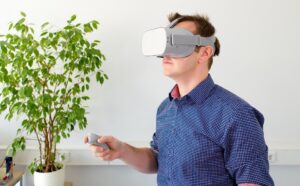WiMi Hologram Cloud, a prominent leader in Augmented Reality (AR) technology, is developing an innovative Human-Robot Collaboration system. The system is based on revolutionary digital twin technology. The major aim of this system is to amplify natural human skills, unlock untapped potentials, and allow unhindered human-robot collaboration. Through the integration of human and robot digital models, the system can effectively improve its relations. It garners/gathers adequate knowledge of collaborative skills, experiences, and patterns of interactions. This enables the advancement of decision-making and innovative mechanisms. With this system, humans and robots can explore new heights of interaction. This is possible because it carefully combines the flexible and adaptable nature of humans with the accuracy and precision of robots.
The human-robot collaboration system uses different sensory devices to capture the behavioral patterns of humans. The collected information is, in turn, refined by its receptive system. The embedded receptive system extracts different features and leverages deep learning algorithms to define the accurate strategy for action.
Following this, the results are evaluated by the decision system before presenting the selected behaviors. Usually, these behaviors are presented through a visual interface, which provides several guidelines to guide human actions. Up Next, is the construction of the digital twin space. A Digital twin space is an accurate representation of the physical environment.
Physical environments are virtually represented to represent digital models that imitate their behavior in the real world. By that token, Digital twin technology amplifies the presentation of physical environments through the use of reciprocating feedback between virtual and physical realms, Data optimization, decisions, and integration.
In physical environments, humans and robots interact and exchange information. The information is transferred to the digital twin space for enhancement., which also provides feedback on the processed results. Through continued optimization, the performance of each system improves, leading to the enhanced operation of the human-robot collaboration system.
By extension, Digital twin technology aligns with the adaptive nature of human-robot collaboration systems. It accomplishes virtual simulation by incorporating feedback between the digital and physical space. The changes that occur in the digital models serve as feedback displayed through an interactive interface.
Conclusively, WiMi’s digital twin technology develops a Human-Robot Collaboration system that enables seamless interaction between humans and robots. It allows humans and robots to share, coordinate and use information across physical and virtual spaces.
Following a human-based guideline, both parties have equal control and decision-making power. Both parties combine efforts and abilities to enhance skills and achieve common goals. Based on the increasing trend of Ai, human-robot collaboration has become an integral part of the physical world. It is also incremental to the development of AI. By that token, posterity will witness the improved coexistence of humans and AI in society.
Follow us on LinkedIn
Read other Articles





